| Main | CB | FB | Fast | Size | Keel | Ballast | Point | Tall | Race | Lean | Ocean |
|
|
John Vigor, a reviewer of "good
old boats" in
Twenty |
This is a myth that has no
historical support whatsoever.
It appears to
be a recent perversion of thought fostered by dealers who like new boat
owners to purchase larger and larger boats every 4 or 5
years.
British
naval architects
established in the 1950s that the smallest practical ocean cruiser in the
modern age is a bit less than 20 feet. All the provisions necessary can be
stowed for comfortably and safely circumnavigating the globe in 20 to 30
footers and there are super markets at the remotest of ports of call.
The historical record is full of examples of
those who have done so (Trekka, Flicka,
Kawabunga, Alsvid, Dove, and Varuna
for example.) In 2005 Saltair, a 25+ year old Cal 30,
completed a singlehanded circumnavigation. Bill Morris, an
author on bluewater gear, started the voyage in 2000 out
of San Pedro, California. (Ocean Voyager 2006 pg 6)
The myth
is supported by literature that makes ocean cruising appear more dangerous
than mountain downhill skiing or river rafting. One theory is that those who
circumnavigate in a 30 foot or smaller ocean cruiser without a life
threatening story to tell simply do not get the experience in print. I
have been told that ocean
racing rules perpetuate the notion that
vessels under 60 feet are somehow undesirable. But when I
was growing up entire harbors, such as Dana Point Harbor,
were designed with the notion that recreational vessels for
ocean cruising would rairly exceed 35 feet. Larger vessels
in harbors not designed for them are hazards.
There is the fear of capsizing, to be considered. Sail boat owners have been known to put tons of lead pellets, (several hundred pounds of sand mixed in rezen - 26M) or 4 times the needed water and canned goods and anchor tackle, in bilges because of the fear of capsizing. |
"A common misconception about sailboats is that 'bigger' means 'safer'. That is simply not true. ... In fact, there are sea and weather conditions when a smaller trailerable sailboat may actually be safer than a much larger sailboat."
Dr. Jerry Cardwell
Sailing Big on a Small Sailboat
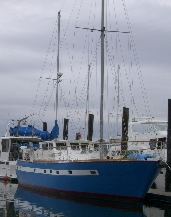
 A ship is a vessel over 20
meters (65 feet). Hence the word "small" in the term "small craft
warning" may be taken as a warning for vessels under 65 feet. Perhaps
that also perpetuates this myth. Small
craft warnings
are
issued when winds during the period of the forecast are expected to (even
briefly) reach 33 knots (38 mph).
A ship is a vessel over 20
meters (65 feet). Hence the word "small" in the term "small craft
warning" may be taken as a warning for vessels under 65 feet. Perhaps
that also perpetuates this myth. Small
craft warnings
are
issued when winds during the period of the forecast are expected to (even
briefly) reach 33 knots (38 mph).
Analysis of popular cruising
areas
reveals that 98% of the time winds are between 4 and 21 knots (4.6 and
24.15 MPH). 93% of the
time they are between between 4 and 16
knots (4.6 and 18.4 MPH). Yet in the Pacific Northwest and other cruising
areas where sport fishing is common, the causal boater may conclude that
conditions are dangerous much more often than not.
Since a typical cruiser spends 90 % of its time at anchor or docked or on the hard, one can expect that the vessel will be protected during the 2% of the time when conditions are dangerous. This is especially true with Mac26x cruisers which owing to their shoal draft have ample all weather anchorages to choose from even on notorious coastlines such as the coast of California. The light weight of the Mac26x cruisers and chain plate strength allow them to be lifted for storage ashore during the worst of storms.
In March of 2004 I met with two crews who had recently sailed to the South Seas. The first crew was satisfied with their experience in a 36 footer and I was pleased to know that they made passage with an even smaller vessel - a 24 foot Flicka. They reported that most of the monohulls were larger vessels. The second crew sailed a 50 footer. They were pleased with fast passage times however they concluded that a monohull of between 38 to 42 feet might have been more suitable. They made passage with a multi-hull and were unable to enter protected anchorages enjoyed by the shoal draft vessel. In addition the eight foot keel made navigation difficult and in spite of great caution a coral head was hit - fortunately with little damage. Poor anchorage also means more equipment breakage. At one point a furled headsail broke loose at anchor causing the 50 footer to break her moorage.
Because the roler furling mechanism was broken, the sloop circled under motor power in misserable conditions, each circle reducing the Genoa until finally it could be secured. Almost everything broke on the 50 footer and her captain reported at one point she instructed crew not to touch anything because one more broken item would drive her crazy. Renewing a piece of hardware always ment ordering the next size up, at the next price up, from what other south seas captains would order for boats just 10 feet smaller. The point is that shoal draft vessels can take advantage of anchorages where less wear and tear on the vessel means safer, and less expensive owing to equipment failure, passages later.
Raising the bottom edge of the cabin entry not only made the rear berth more accessible, but lessened the chance of flooding the cabin in the event the cockpit was filled with a severe following sea.Since in a severe following sea, such as is common at lower tides at the shoaled entrance to a river during an incoming tide, you are instructed to close the hatch, the "but" part of the statement should be ignored. Better of course is timing ones entrance and planning ones passage to avoid waters where steep wave conditions are possible. That information is available in notices and guide books and publications involving tides. You can also drop sail and motor at the speed of the wave (surf it) to avoid the chance of flooding - also called pooping) which is how the Grady White and Boston Whaler sport fishing boats handle sever following sea. Retractable foils make that possible on a sailboat with a large engine like the X or M. (You learn to surf under motor power real fast in the Mac26x and I suspect that is also true with the M.). In the X brochure is the statement:
Unlike most small powerboats, the MacGregor 26 (x) is not open to the sea, so it is suitable for offshore or rough water operation. Also, there are no thru hulls below the waterline that might allow water leaks into the interior of the boat. Powerboat enthusiasts should note too that, with the MacGregor, if the outboard ever breaks down you could always sail home!
In heavy air and big seas light modern sail boat designs may not be able to heave-to. This involves backwinding the headsail, letting out the main, and waiting for calmer conditions. Lying ahull (dropping all sail) is another technique for waiting out a storm but this eventually leads to broaching in modern light fixed fin boats with knock downs and capsize becoming of grave concern. Running ahead of the storm (surfing the waves) may not be a possibility owing to lack of sea room. Dodging will then be deployed as a necessary survival technique.
Dodging involves heading into the wind with the engine at moderate RPMs with a small rolled in foresail. It is commonly deployed on modern light boats with roller reefing Genoas when the boats encounter ugly conditions. Fortunately modern outboards are not prone to flooding but on the smaller boats eventually fuel will be exhaused. It is best to have a boat that heaves to and lies ahull well. The Mac26x reportedly does both well. These craft are quite unusual in that while the light displacement would indicate poor heavy weather performance, in reality they do perform just like a heavy keel boat in that regard. In 4 to 6 foot steep seas Murrelet pointed herself into the waves and lied ahull quit piecefully during a rough Haro streight crossing. During a passage from Seattle to Olympia in March of 2005, I was able to verify that the boat lies ahull exceptionally well and waited out several rough patches. I did not have to remove the full cockpit enclosure but I did extend all foils, including the outboard, so the boat would head into the breaking waves without the use of engine or sail. I have confirmed the reports.
As long as a schedule need not be followed, I doubt that in 20 years of sailing Murrelet will ever be in conditions that are dangerous. Monitoring the weather provides enough advanced warning to sail or if needed power away from weather of concern, assuming normal precautions, like shutting hatches and selecting an easy course and speed, are taken. Speed is important.
"Unfortunately, the speed range for typical displacement boats between 20 and 50 feet is only five to 10 knots- not nearly enough for many recreational roles. True, slow moving, full displacement vessels are reasonably efficient at carrying heavy loads because buoyancy forces sustain the weight for free, and only modest engine power is needed to slide it along. Greater pace usually requires planing hull forms that can lift the entire boat enough to minimize skin friction and wave-making loss."
Sven Donaldson
Pacific Yachting, January 2006 pg 55
At the February 2008 Seattle Boat Show, I learned that Pacific Seacraft had ceased operations. This sad event was inevitable. A modern design ocean sailboat should be capable of making way at close to if not above double digits. This speed allows the captain to make use of modern weather, tide and current reporting. If the hull of the sail boat limits her to under 10 mph (as is the case with displacement hulls under 40 feet) the safety that modern reporting provides is compromised. The ocean is not a place for compromise. Hence the noteworthy ocean pocket cruisers of the past, such as the Danas and Flickas of Pacific Seacraft, are desirable today for historical rather than safety reasons. Sailing and motoring fast have become the primary safety features in recreational boat design. Unlike Davy Jones - the objective is to avoid harms way. But like him, no modern ocean sailor should tolerate a slow boat or delay in mounting a fast engine or learning how to sail at fast speed.
I have been told that it is good luck to get caught in a gale or storm when first learning to sail because newbes are likely to survive, so is the sailboat, and because it is very unlikely the crew will get caught a second time, all other sailing endeavors will appear easy. However, with modern reporting and reasonable speed that kind of luck isn't likely. Today a sailor must actively seak or conciously choose seasons and crossings where disaster is possible and then set out to challenge them in a slow boat. The conscious choice is reflected in offshore boat insurance policies which require captains to avail themselves of modern reporting prior to leaving harbor. The crew of the Murrelet is weather cognisant. We enter conditions in the log book. However, Max26x vessels are sailboats after all and small craft warnings are cherished conditions.
Slow boats continue to be manufactured. You will find new models every year. They are easy to spot. If the sailboat is under 40 foot and a displacement hull, by physics the boat is slow. These slow boats must be fitted out like tanks to be ocean worthy because they can not motor or sail fast enough to avoid dangerous conditions, like a tidal current or predicted storm.
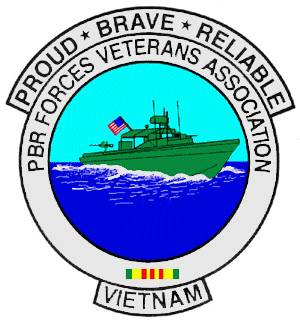 Mac26x
and Ms are strong
enough to handle storm conditions which are
encountered routinely during the process of and while
trailering. Hurricane force winds are encountered when
trailering. Mac26x cruisers remind me of the fiberglass PBRs of
the
Vietnam
war because they likely can be dropped 25 feet from a lift
without
being damaged like PBRs were from helecopters.
One Mac26x toppled
off
its trailer down an Indeo California highway embankment with
no
structural
damage other than stanchions being bent.
Mac26x
and Ms are strong
enough to handle storm conditions which are
encountered routinely during the process of and while
trailering. Hurricane force winds are encountered when
trailering. Mac26x cruisers remind me of the fiberglass PBRs of
the
Vietnam
war because they likely can be dropped 25 feet from a lift
without
being damaged like PBRs were from helecopters.
One Mac26x toppled
off
its trailer down an Indeo California highway embankment with
no
structural
damage other than stanchions being bent.
750 PBRs were minted directly from Uniflite 31 foot Sports Sedan molds in Belingham Washington in the 1960s and at least 300 of the Uniflite patrol boats saw duty in Vietnam. The four man PBR crews were trained near Catalina Island in Coronodo, south of the MacGregor Yachts factory, as well as in the San Francisco bay where I grew up and their production influenced west coast boat designers and builders such as Roger MacGregor and Robert Perry, if not the designers and builders on the east coast. Perrys Valiant sailboat design was initially produced by Art Nordtvedt, the founder and manager of Uniflite. Water jet propulion became acceptable on the west coast for boat design owing to PBRs and hence Personal Water Craft share a heritage with the war boats.
The recent recovery of a half dozen PBR vessels demonstrates that after 40 years the 1/4 inch laminated hulls show no signs of deterioration or warping.
Also like the PBRs, Mac26x cruisers are fast so they can make passage before tide changes create current hazards and they sport powerful engines useful in fighting strong currents as well as making port before sundown. The PBRs could operate in less than a foot of water; Mac26x cruisers require only 9 inches. Ms a few inches more. The major finding regarding Mac26x cruisers from his book is that dealers told Dr. Cardwell that the Mac26x has an additional layer of glass fiber throughout the hull than is normal for trailerables. This was done because there was a question about the vibration and pounding the hull would take owing to motoring at wide open throttle with the standard 50 hp engine. Like PBRs, Mac26x and m vessels have solid foam floatation.It is not suprising that many military families own Mac26x cruisers. If the battleship was sinking, its crew would board small motorized life boats that are not unlike Mac26x cruisers. Both vessels have solid foam floatation and hull forms that do well in heavy sea. Owing to sails, the X boats have unlimited range hence betering PBRs. PBRs sported two waterjet Jacuzzi fitted two stroke V-6 Detroit6V53 engines rather than outboards but both boats are operated at speeds over 20 knots and both vessels pull water skiers. Both were built on the west coast of the USA, the PBRs in Washington State and the X boats in California. A PBR is featured in the dark film Apocalypse Now and the Mac26x in the dark film Tease. Documented Mac26x cruisers can be commisioned by the US armed forces in a time of need and hence the theft of one of them is treated like the theft of any US Navy vessel. The description of a Mac26x as a "fun" boat, ignores the serious functionality portrayed by comparing the vessel with its Spartan interior to a PBR war boat. Solid flotation means there is less worry regarding capsizing. All recreational boats, regardless of size, in sufficient sea, can capsize.
Analysis of disasters at sea usually find that the vessel was unable to recover from a capsize as quickly as it might have owing to ballast shifting. Even so many capsized vessels are later recovered, and there is a growing school of thought that their crew would have also been recovered safely had they not abandoned ship. It is even being suggested that life rafts be banned from ocean cruisers so that crew are not inclined to concentrate efforts on deploying them over seeking shelter in the capsized vessel until weather permits a righting. The Mac26x and m models have a life raft built into them owing to solid flotation. When fitted with a mechanism for blowing or pumping water ballast the ballast tanks are water tight compartments further adding to safety.
Mac26x capsizes likely all involved skipper error, and most involve partially filled ballast such as the cruiser near Oakland with a full load of passengers that capsized during the process of emptying ballast outside of (instead of within) a 3 mile protected channel). The most recent reported capsize was in the Bristol Channel U. K. Apparently the owner headed out to sea with the valve open to empty ballast and power at speed with bare poles (no sails). He came upon rough water slowed, forgot about the valve being open, and suffered a capsize likely owing to partial refilling of the ballast tank. This was a new owner who abandoned the vessel with the help of rescuers.

Capsizing is not as dangerous an event for vessels with solid flotation. The Bristol Channel Mac26x could have been saved by putting out an anchor, the owners returning when seas permitted righting her. The boat was only a couple weeks old.
There have been other incidents in Lake Erie and off Catalina Island. The later apparently involving motoring fast with sails up and centerboard and rudders down which would also be skipper error. Controversy involving a July 4 2002 drunken boater capsize does not explain MacGregor Yachts introduction of the 26M, though it may have been a contributing factor. No one is happy with the negative publicity. The prosecutor of the captain responsible for two children's deaths was unable to remove design questions from the case, hence partaily absolving the captain and putting the yacht company in a position of blame. The operator instructions for the vessel are posted. These read:
"The ballast tank should be full when under sail in rough conditions. It is a good idea to have the tank full when there are more that 4 adults on the boat. When powering over 6 MPH, the rudders and centerboard must be fully up. Lower sail. When operating at any speed without a full water ballast tank, no one should be on the cabin top or foredeck, and crew weight should be low and toward the rear of the boat."
The involvement of Jim Teeters, technical advisor to US Sailing, in defending the drunken captain, who had a prior felony conviction, appears related to vested interests in box design rules and objections to IRC. Taylor, a naval architect from Michigan, testified that the Mac26x does not have design flaws and can be piloted safely. The Mac26x was never really on trial. In some respects, the case can be viewed as hastening the reorganization of US Sailing after an attempt to delay the water ballast friendly IRC. For more see IRC, ISAF and US Sailing
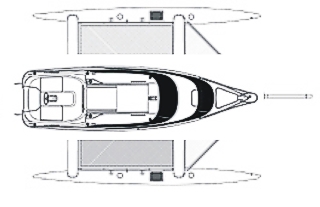 There is a
saying involving boats that stability isn't everything it is
the only thing. The M hull form, more weight aloft, stiffer mast and
greater sail area make the M less stable than the X.
http://www.macgregor26.com/safety.htm
compares the more restrictive safety
requirements for the M with those of the X. In the context of Robert
Perry's positive review of the 26M November 2003
Sailing magazine where
prior to the review he describes a trimaran whose center hull was later
marketed as a mono-hull, there is need to consider the possibility that
the max26M may be part of a multi-hull roll out. This possibility is
supported by MacGregor Yachts description of the M's rotating mast, which
is not mentioned in Perry's review. The M's mast rotation gives up to 30
percent more power and would normally be engineered to be shorter if
intended solely for mono-hull use on a boat to be crewed safely by no more
than 4 as the M is. A trimaran configuration would take advantage of the
power in the M's rotating mast and also balance out the M hull, allowing
larger head sails on a bowsprit, more crew to be carried, and in
unballasted configuration might be quite fast. MacGregor Yacht's has
an impressive history in transportable catamaran designs with
variable beams and describes the
M mast as a multihull mast. It doesn't seam far fetched that the
combination of one of Macgregor Yachts catamarans with the M hull to make
a variable beam trimaran (VBT or BLT in Perry's terminology) may be in
the works. Perry seams to have helped MacGregor move in
this direction by announcing that the internal ballast in future Ms is to
be in the form of easy to remove lead (likely pellets). I very much like
this notion of the M
being part of a mult-hull roll out because most engineers see the X as a
revolutionary sailing machine and the M as conventional in its monohull
less forgiving and less balanced form (in comparison to the X and other
MacGregor monohulls.). Practical Sailor quotes
an X owner as saying
There is a
saying involving boats that stability isn't everything it is
the only thing. The M hull form, more weight aloft, stiffer mast and
greater sail area make the M less stable than the X.
http://www.macgregor26.com/safety.htm
compares the more restrictive safety
requirements for the M with those of the X. In the context of Robert
Perry's positive review of the 26M November 2003
Sailing magazine where
prior to the review he describes a trimaran whose center hull was later
marketed as a mono-hull, there is need to consider the possibility that
the max26M may be part of a multi-hull roll out. This possibility is
supported by MacGregor Yachts description of the M's rotating mast, which
is not mentioned in Perry's review. The M's mast rotation gives up to 30
percent more power and would normally be engineered to be shorter if
intended solely for mono-hull use on a boat to be crewed safely by no more
than 4 as the M is. A trimaran configuration would take advantage of the
power in the M's rotating mast and also balance out the M hull, allowing
larger head sails on a bowsprit, more crew to be carried, and in
unballasted configuration might be quite fast. MacGregor Yacht's has
an impressive history in transportable catamaran designs with
variable beams and describes the
M mast as a multihull mast. It doesn't seam far fetched that the
combination of one of Macgregor Yachts catamarans with the M hull to make
a variable beam trimaran (VBT or BLT in Perry's terminology) may be in
the works. Perry seams to have helped MacGregor move in
this direction by announcing that the internal ballast in future Ms is to
be in the form of easy to remove lead (likely pellets). I very much like
this notion of the M
being part of a mult-hull roll out because most engineers see the X as a
revolutionary sailing machine and the M as conventional in its monohull
less forgiving and less balanced form (in comparison to the X and other
MacGregor monohulls.). Practical Sailor quotes
an X owner as saying
"She is fast enough to be pleasurable, forgiving enough that I can be stupid, balanced enough that I can be lazy."
Skipper error or unknown reason, Mac26x boats are self righting when fully ballasted and will right themselves or are easy to right when the ballast tank is completely empty. It is the partially full tanks where capsize may create righting problems. Owners report that it is a very difficult to knockdown the vessel, perhaps not even possible under sail.
Cruising sailboats just do not need to be large. The safety from storms afforded a large boat comes primarily from the speed she can make and modern materials and know how allow small cruisers to operate at those speeds, all be it with less of the shore-like home accomodations possible on a large cruiser.
Several modifications make a large difference in how crew approach pocket cruising. Pocket cruising is a term that applies to sail boats 27 foot and under. This is a challenging form of cruising owing to space limitations. For Mac26x cruisers, simple things make a big difference. Many of them are inexpensive. Over 6 years I find the following most valuable:
 1. 2 gal
water jugs. I usually have 4 or more aboard. Pouring is a lot
easier than pumping and no one will drink from a sail boat's water tanks.
When empty the jugs are extra flotation. They can be filled with salt
water for
rinsing and with dirty dish water you may not want to dump
at a sensitive pristine gunkhole.
1. 2 gal
water jugs. I usually have 4 or more aboard. Pouring is a lot
easier than pumping and no one will drink from a sail boat's water tanks.
When empty the jugs are extra flotation. They can be filled with salt
water for
rinsing and with dirty dish water you may not want to dump
at a sensitive pristine gunkhole.
2. Baby Wipes. Why no one markets these as Mariner Wipes is a mystery.
Murrelet has a shower drain and one of these days someone will figure out
the
plumbing necessary for drawing water out of the ballast tank to be used
for showering. Then the ballast tank could be flooded with lake water
prior to venturing into salt and used for showering, salt water
replacing what ever is used. While not as convienent as the baby wipes we
rig
a sun shower and feed the water into the head compartment as other X
owners do. I do not
believe the Mac26m will be able to support a below deck shower. The head
compartment is in a bad spot both for draining and venting. The Mac26x may
be
the only solid flotation monohull pocket cruiser capable of adding a
shower. Baby wipes are still important, however.
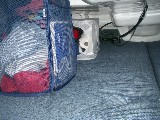 3. Bed
Bath & Beyond Expandable Hampers - the singles are
perfect for the void space under the Mac26x cockpit. Crew store
personal gear in them. They can go on deck at night under a cover. When
not full of gear they can be used like a cargo net; once inserted into
a storage compartment they expand flat and should prevent items from
spilling out should there be a capsize. In 2004 we intend to test older
ones out as sea anchors.
3. Bed
Bath & Beyond Expandable Hampers - the singles are
perfect for the void space under the Mac26x cockpit. Crew store
personal gear in them. They can go on deck at night under a cover. When
not full of gear they can be used like a cargo net; once inserted into
a storage compartment they expand flat and should prevent items from
spilling out should there be a capsize. In 2004 we intend to test older
ones out as sea anchors.
4. Zip Loc storage bags. The small ones keep tins from rusting. The large ones are good for keeping important documents dry as well as spare electrical parts and you can even use them for food storage!
5. Canvas bags - lots of them. Our shore power kits, chargers and adapters go right in after being zip locked and we move the bags from compartment to compartment depending on who is sitting where when storing them. If they mildew - we wash them or pitch them.
6. Tape Lint brush. For several years I used a car vac. The Tape Lint Brushes just work better, store better, and no power is required. Any dry cleaner and many drug stores carry them and refills. They pick up everything where a vacuum will not and no noise.
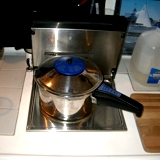 7.
Pressure Cooker. Just can not see any sail boat with out one any more.
Modern ones do not explode and when sealed they can't be knocked over
spilling contents. They sterilize dirty utensils. I also use it to heat
water.
7.
Pressure Cooker. Just can not see any sail boat with out one any more.
Modern ones do not explode and when sealed they can't be knocked over
spilling contents. They sterilize dirty utensils. I also use it to heat
water.
 8.
Pressure Sprayer. The $18 plastic kind you use to spray down roses -
but you want one that has never been used for that purpose. Why no one has
invented a shower head for these things and called them Mariner Sprayers
is another mystery. We store the sprayer in the head compartment and use
it for washing hands and spraying down the cockpit. Use it to hose off
sandy feet and cool off on a hot day.
8.
Pressure Sprayer. The $18 plastic kind you use to spray down roses -
but you want one that has never been used for that purpose. Why no one has
invented a shower head for these things and called them Mariner Sprayers
is another mystery. We store the sprayer in the head compartment and use
it for washing hands and spraying down the cockpit. Use it to hose off
sandy feet and cool off on a hot day.
 9.
Heaters. Electric ones for dockside and the Wallas Marine kind for
underway, We have even carried propane ones. Of course ventilation and CO
are issues to
watch for. But in cramped quarters being damp and cold isn't worth it. The
electric marine heaters are around $40. A good Wallas Marine burning paint
thinner (yep odd but true) will be about $800 and will serve as a cooker.
I don't really use propane that much but suspect it is acceptable. Check
out the Sailing Today October 2002 issue featuring Wallas Marine and also
containing a review of the Mac26X.
9.
Heaters. Electric ones for dockside and the Wallas Marine kind for
underway, We have even carried propane ones. Of course ventilation and CO
are issues to
watch for. But in cramped quarters being damp and cold isn't worth it. The
electric marine heaters are around $40. A good Wallas Marine burning paint
thinner (yep odd but true) will be about $800 and will serve as a cooker.
I don't really use propane that much but suspect it is acceptable. Check
out the Sailing Today October 2002 issue featuring Wallas Marine and also
containing a review of the Mac26X.
10. Turkey baister - the kind with a bulb. Not for cooking but rather for sucking out bilge water. Condensation can be a problem on pocket cruisers and a Mac26x can really condense water in the proper conditions. Sponging just gives you a chance to drip water on the carpet. The baister is also useful in sucking out a clog from the engine well or one of the sinks.
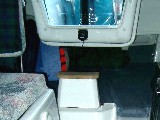 11.
Step
stool. Like the kind on the pre 2000 Mac26x cruisers. We
use
that stool for showering and it sets up nice near the sink for washing
dishes below deck. Fits on the carpet mid ship like a thwart on a dinghy
and will save the back of any galley slave owing to tight quarters where
the designer decided the galley sink had to go (likely for mathematical
stability
calculations). Its a bad spot, but not so bad when using a stool. Later
model X cruisers replaced the step with a ladder and removed the step
platform. I considered modifying Murrelet in a similar fashion but
decided that the step provided more utility. On a pocket cruiser every
feature should perform more than one function. In addition to serving
as a stool for showering and dish washing the X step qualifies as an
emergency bailer. The step base is used for storing the aft anchor
tackle. In early model X cruisers it contained access for checking the
water ballast tanks.
11.
Step
stool. Like the kind on the pre 2000 Mac26x cruisers. We
use
that stool for showering and it sets up nice near the sink for washing
dishes below deck. Fits on the carpet mid ship like a thwart on a dinghy
and will save the back of any galley slave owing to tight quarters where
the designer decided the galley sink had to go (likely for mathematical
stability
calculations). Its a bad spot, but not so bad when using a stool. Later
model X cruisers replaced the step with a ladder and removed the step
platform. I considered modifying Murrelet in a similar fashion but
decided that the step provided more utility. On a pocket cruiser every
feature should perform more than one function. In addition to serving
as a stool for showering and dish washing the X step qualifies as an
emergency bailer. The step base is used for storing the aft anchor
tackle. In early model X cruisers it contained access for checking the
water ballast tanks.
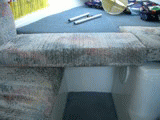 12. Full size
goose down comforters. These set up well in the V
birth or aft. One can be put down to lay on providing more cushion to the
mats and one on top for warmth. They pack down well for storing. You
forget
you are on a pocket cruiser when in them. As fine a berth as a 60 footer,
especially when the V berth is extended by using the forward seat back. On
the Mac26x you have sky lights right where you want them for star
gazing.
12. Full size
goose down comforters. These set up well in the V
birth or aft. One can be put down to lay on providing more cushion to the
mats and one on top for warmth. They pack down well for storing. You
forget
you are on a pocket cruiser when in them. As fine a berth as a 60 footer,
especially when the V berth is extended by using the forward seat back. On
the Mac26x you have sky lights right where you want them for star
gazing.
The notion that the ensign should fly from
the stern came from the tradition of making the aft quarters the place
of honor for the captain and his wife. Owing to the skylight, forward deck
hatch and V birth extention, most X owners will choose the V berth over
the larger sleeping area in the stern. The animation to the right shows
how
the V-berth bedding is stored. Owing to the head on the Mac26m such
V-berth luxury is not possible.
13. Office supply
document racks. The clear ones are nice. These can be
mounted with pop rivets through the Mac26x liner once you decide on where
you want them. They can be affixed with the supplied wall tape for a
season. We have four. All are mounted on the port side starting above the
sink
and going forward. Your vessel's owner manual, ships log, and boating
magazines can be displayed there. Aids to navigation, Birding and marine
life guides, fishing materials etc. The Mac26m does not have the liner
necesary for the use of pop rivits. Racks such as those portrayed to
the right would be difficult to fasten owing to the lack of a liner.
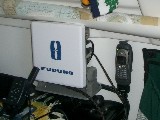 14. Cell phone.
Times have changed. You still will want a radio but
we want to phone for reservations at places
that are not monitoring radio. In addition, because we may tie to a public
dock rather than messing with an
anchor and dinghy we want to post the cell phone number conspicuously in
case
some one wants the boat moved. We have a phone charger mounted
on the vessel's starboard side.
14. Cell phone.
Times have changed. You still will want a radio but
we want to phone for reservations at places
that are not monitoring radio. In addition, because we may tie to a public
dock rather than messing with an
anchor and dinghy we want to post the cell phone number conspicuously in
case
some one wants the boat moved. We have a phone charger mounted
on the vessel's starboard side.
15. Gell Batteries. Unless you are operating in very warm climates, you really have no reason not to use gell batteries on a pocket cruiser. Think about crew stuffing gear in compartments that also have batteries in them. I do not want battery liquid to deal with ever. Added benefit: if the cruiser is ever capsized, gell batteries will still provide power. That isn't true with lead acid ones.
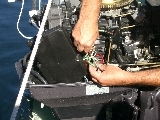 16. An engine that can be hand cranked. I have twice left the cruiser for
a few days or week and came back to discover that something, a light or
radio, had been left on and the batteries were dead. Gell batteries are
not damaged by that. Lead Acid ones are. In both cases, shore power was a
distance away. Also in both cases I was able to get a jump or sail to a
location to power back up. On a third episode, salt corrosion prevented
electrical starting but hand cranking worked (one pull). A dinghy engine
and tow would also do. Some one to call for a
jump is also nice. Check lists are nice but they only work when who ever
visits your vessel while you are gone uses them. I keep the check list in
those office supply document racks. Nothing, especially an A/B switch,
will solve this pocket cruising problem. If we are moving the boat north
for example, I may have a technician visit while we are not there,
leave the key with the harbor master or hide a key, something like that. I
find the check list will not get used prior to his/her departure. An
engine that can ge hand cranked makes the pocket cruiser more self-
sufficient which is important for an ocean sailboat.
16. An engine that can be hand cranked. I have twice left the cruiser for
a few days or week and came back to discover that something, a light or
radio, had been left on and the batteries were dead. Gell batteries are
not damaged by that. Lead Acid ones are. In both cases, shore power was a
distance away. Also in both cases I was able to get a jump or sail to a
location to power back up. On a third episode, salt corrosion prevented
electrical starting but hand cranking worked (one pull). A dinghy engine
and tow would also do. Some one to call for a
jump is also nice. Check lists are nice but they only work when who ever
visits your vessel while you are gone uses them. I keep the check list in
those office supply document racks. Nothing, especially an A/B switch,
will solve this pocket cruising problem. If we are moving the boat north
for example, I may have a technician visit while we are not there,
leave the key with the harbor master or hide a key, something like that. I
find the check list will not get used prior to his/her departure. An
engine that can ge hand cranked makes the pocket cruiser more self-
sufficient which is important for an ocean sailboat.
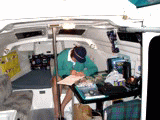 17.
A real table. I read an article about a couple who were purchasing
their third or fourth sail boat. They had one non negotiable requirement.
That was for a table below decks that DID NOT HAVE THE MAST OR A SUPPORT
POKING THROUGH IT. I never really thought about that until the article but
with out something you can lay out gear on unobstructed, every little
project (packing, repairing, cooking, eating, navigation, loading
batteries into a gizmo, whatever) becomes a geometry exercise. We cover
the Mac26x table to protect it or use the earthquake place mats they are
selling now at marine supply shops. Some one figured that one out. The
mats prevent your project from rolling off the table when a power boat
wake disturbs the moorage. My Mac26x cruiser also has a plexi class
cover that is useful for document and
chart display and no mast or support poking through.
17.
A real table. I read an article about a couple who were purchasing
their third or fourth sail boat. They had one non negotiable requirement.
That was for a table below decks that DID NOT HAVE THE MAST OR A SUPPORT
POKING THROUGH IT. I never really thought about that until the article but
with out something you can lay out gear on unobstructed, every little
project (packing, repairing, cooking, eating, navigation, loading
batteries into a gizmo, whatever) becomes a geometry exercise. We cover
the Mac26x table to protect it or use the earthquake place mats they are
selling now at marine supply shops. Some one figured that one out. The
mats prevent your project from rolling off the table when a power boat
wake disturbs the moorage. My Mac26x cruiser also has a plexi class
cover that is useful for document and
chart display and no mast or support poking through.
18. Chart Guard. We have the Garmen 176c color GPS unit and the blue charts and that is nice. But nothing beats a big piece of paper on deck for piloting. We were visiting a book store (the Armchair Sailor) and discovered these $30 chart guards. My wife got one and I didn't think much of the gift until I started using it. The guard not only keeps the chart dry but it also prevents it from blowing away and you can turn it and bend it with out damaging the chartbooks they cover. Since each of those books runs $80, it is worth the investment if you are going to use the charts topside. I later purchased a second because they also work well as frames for displaying the charts on a basement wall.
19. Cockpit cushions. I have tried to do without them but in the final analysis we want them if cruising any distance. They are a problem on the Mac26x because they get water logged if rained on or hosed off. But the water doesn't harm them. I have gone weeks with out drying them out. Unfortunately it also takes weeks to dry them in my basement. The flat fenders can be used as knee and bottom guards and don't fade in sun. I use those when docked as seats when the cushions are stored. The cockpit cushions fold well so there isn't any reason to stand on them. You just unsnap and fold up before boarding or disembarking, setting sail, fueling, loading etc. You can also move them from side to side.
20. Thermal Refrigerator. The $140 Coleman kind. It isn't that I need to have refrigeration it is just that it takes a lot of effort to cart food and beer to the cruiser. The Mac26x comes with a Coleman ice chest and the idea is that you cart that back and forth from boat to home. Heck that's work. If its on the boat it stays there. I am not carting it back - no way. I don't want it to go bad so hence the thermal. If you remove the liner for the ice chest storage compartment, the fit is near perfect on the Mac26x. Many Mac26x owners remove the ice chest from its designed place under the aft dinette seat and use this for storage. The ice chest storage compartment is the only finished compartment on the vessel and the ice chest itself can be possitioned as they are on the Mac26m or better yet under the table. Mac26x pocket cruisers originally were fitted out with Coleman ice chests by the factory. Many boaters do not know that Coleman (the outdoor equipment firm) purchased Hobie Cat Company (at the time a public company) in the 1970s with Hobie Alter becoming a consultant to Coleman. Since the only finished storage compartment on an X houses the ice chest, Coleman was honored by - if not connected to - MacGregor Yachts, prior to the introduction of the M (which is not fitted out with a chest by the factory). Perhaps today's camping image for Coleman is not in keeping with the M's big boat interior which often includes a TV/DVD system. In anycase the Mac26x is tied to the Hobie Cat beach boats through its ice chest and also through Hobie Cat athletes. Remember that MacGregor produced cruising cats for many years. Many owners (not me) beach Mac26x cruisers like a catamaran. I have listened to many versions of a story involving Hobie Cat athletes sailing a Mac26x at 17 MPH in Mexican or San Franciscan waters and one of these days I will bump into a first hand witness, assuming the story is true. The story usually involves a fleet of Hobie Cats with a Mac26x serving as mother ship. The Cats take off and those left on the mother ship take chase and achieve 17MPH under sail. Most assume the athletes on the mother ship hiked out and sailed unballasted. However, having achieved 12 and 13 MPH on several occasions now fully ballasted - with crew sitting inside the life lines - I doubt the X was unballasted or rigged so that hiking out could be supported. One captain has reported to Sailnet of reaching 17 MPH by starting off fully ballasted and dropping the ballast after stabilizing the boat on a downwind point of sail. Even if the Hobie-cat athelete-crewed Mac26x story is fable, pocket rocket is a valid descriptor for the vessel. Bottom line - on an X there should be some kind of Coleman equipment aboard just for tradition.
21.
Shore power. My dealer put up a fuss but shore power is one heck of a
nice modification for a pocket cruiser. You need electric heat and you
need ventilation fans and sure an electric cord may do but then where is
your wife going to plug in the hair dryer. You feel a lot better about
your dock purchase instead of free anchoring out when you can use the
electrical services the docks provide. I use to keep an iron on board and
plug that in to freshen up and dry garments but discovered that is
something the bottom of the pressure cooker does well.
22. Baking soda. Not for baking but for the bilge smells. The refrigerator kind with flow through are best. The baking soda also works well as a deck cleaner and I understand it will put out a grease fire. Why someone doesn't market this as Marine soda is another mystery.
23. CO2 alarm. 24 bucks. Who wants to die while they are sleeping because of something not vented well on board or the guy next to you running his generator.
24. Miny hammock. The kind they sell for hanging fruit. We strap that under the Mac26x table. Seemed a natural thing to do. Most visitors comment. It is against the starboard side and the inflatable life harnesses and straps wedge well behind it. Takes zero space and 4 can still sit at the table. We have a second hammock but it has never been deployed. You can get a lot of junk in one.
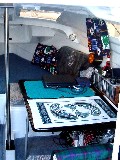 25.
Digital camera. Actually I have an entire digital dark room aboard.
The cameras with viewers are best. I use this to snap pictures of harbor
entrances and also boat modification ideas. Then transfer those to a lap
top computer. I am contemplating removal of the lap top. The GSM cell
phone now gives Internet access and the GPS plotter does the charting and
keeps tide, sun, and moon data. So the only thing the laptop gets used for
now is looking at pictures. As mentioned, many cameras have viewers. Heck
the PC is out of there, Ill get more camera memory cards.
25.
Digital camera. Actually I have an entire digital dark room aboard.
The cameras with viewers are best. I use this to snap pictures of harbor
entrances and also boat modification ideas. Then transfer those to a lap
top computer. I am contemplating removal of the lap top. The GSM cell
phone now gives Internet access and the GPS plotter does the charting and
keeps tide, sun, and moon data. So the only thing the laptop gets used for
now is looking at pictures. As mentioned, many cameras have viewers. Heck
the PC is out of there, Ill get more camera memory cards.
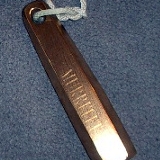 26. Lead Line - no
kidding. Simple things are just better. I understand it
is possible to determine the bottom type by depth sounder. But heck a lead
line will pick up sand, mud, or hit rocks and I can feel that to determine
which anchor to use. It also makes a nice stopper and you can actually
check water depth with it! A lead line is a required item for racing.
The
knots tied in my line are in fathoms. The term knots is derived from knots
in a line. If a line is tied to a float and then released from the stern a
knot tied in the line at the 50 foot interval will pass in 30 seconds if
the boat is going one nautical mile per hour. A knot at the 100 foot
interval would pass if the boat were going two nautical miles per hour.
etc.
26. Lead Line - no
kidding. Simple things are just better. I understand it
is possible to determine the bottom type by depth sounder. But heck a lead
line will pick up sand, mud, or hit rocks and I can feel that to determine
which anchor to use. It also makes a nice stopper and you can actually
check water depth with it! A lead line is a required item for racing.
The
knots tied in my line are in fathoms. The term knots is derived from knots
in a line. If a line is tied to a float and then released from the stern a
knot tied in the line at the 50 foot interval will pass in 30 seconds if
the boat is going one nautical mile per hour. A knot at the 100 foot
interval would pass if the boat were going two nautical miles per hour.
etc.
27. Swiss Army Knifes. I have the Lethermans, but owing to AC cup results and Jimmy Buffet, who has a couple of songs about them, just have to go Swiss. Most important tool is the cork screw. Tin opener is right up there. I have several so there is never much of a need to search for one. These get loaned out to the unprepared we meet while cruising - unprepared meaning no cork screw. So far have yet to loose one.
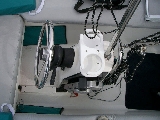 28.
Sail tape. Yes I am stocked with the much in demand duct tape. But I
rarely use that. Sail tape will fix a ripped garment, plug up a hole in a
canvas bag, protect against chaffing. Its great stuff. One day I may even
use it on a sail. The picture to the right shows a cup holder taped above
our SportPilot. An autopilot makes a small boat bigger according to
Cardwell.
28.
Sail tape. Yes I am stocked with the much in demand duct tape. But I
rarely use that. Sail tape will fix a ripped garment, plug up a hole in a
canvas bag, protect against chaffing. Its great stuff. One day I may even
use it on a sail. The picture to the right shows a cup holder taped above
our SportPilot. An autopilot makes a small boat bigger according to
Cardwell.
29. White noise maker. Sometimes the noise coming from floats, roads, lines whipping against masts, the party boat next dock over, or the mate snoring, just has to be dealt with. The battery operated ones are nice. We have had several kinds aboard. Haven't found a marine one - another mystery. Many boaters carry these things.
 30. Cruising Tunes. I have been told a
good sound system is needed to keep
marine mammals from ramming you. The Mureadrita XL, an ILC 40, was
reported to have been struck by a whale on
the way back from the 2006 Pacific Cup. The four aboard eventually
abandoned
her. A sound system may have helped. Nonetheless, some thought
into the
tunes you cart aboard is needed. We copy them from the CDs at home so my
wife always knows the originals are safe. One of the great things about
sail boats is that you can cruise them and listen to tunes WHILE CRUISING.
Our system is built into the boat. If it were not I would have a boom box.
It is just cool. And of course the CDs you can live without make good
rudder shims. At least that is what I am told.
30. Cruising Tunes. I have been told a
good sound system is needed to keep
marine mammals from ramming you. The Mureadrita XL, an ILC 40, was
reported to have been struck by a whale on
the way back from the 2006 Pacific Cup. The four aboard eventually
abandoned
her. A sound system may have helped. Nonetheless, some thought
into the
tunes you cart aboard is needed. We copy them from the CDs at home so my
wife always knows the originals are safe. One of the great things about
sail boats is that you can cruise them and listen to tunes WHILE CRUISING.
Our system is built into the boat. If it were not I would have a boom box.
It is just cool. And of course the CDs you can live without make good
rudder shims. At least that is what I am told.
31. AM/FM radio. Why is it that a cheep $10 GM pocket radio will pick up stations no boat system in the marina can? Look when its game time, I need reception. I do not have an external radio mast but would if I thought it would help. Boats with them miss as well. A real big boat mystery that one. The AM band is a traditional thunderstorm monitoring device on cruisers.
32. Flags. Not that I am a flag freak. But if you hoist a team flag at game time you get a response from the boaters around you. The Mac26x jib hoist works well and since we have roller furling it isn't really used, so up goes the flag at game time. I also have a hoist mounted to the starboard spreader. This is used for signal flags like the Q and O and V and a courtesy flag when out of country (Canada).
33. Picnic supplies, plastic utensils and paper plates, napkins. That kind of stuff. There are always potlucks to join in on. You may not want to wash dishes. Garbage bags are also important. I use the plastic ones with ties and keep that under the galley sink where everyone expects to find it. As soon as the bags are full they are placed in canvas ones that I hang from the X stern, until a garbage scow comes buy.
34. Scissors. Always in demand. That little item is used to cut open food items that are hot out of the pressure cooker. Anything in a microwave serving container can go into a pressure cooker. That includes many bread items. The only thing that can't be heated and snipped open from a pressure cooker is a chicken pot pie (so far at least). The scissors, for reasons I do not understand, often is not in its cubby hole. Swiss army knife can do in a pinch. Scotch tape is also a necessity. One morning, I earned a free breakfast by taping up a carton of milk for transport and rowing it to the omlet maker.
35. Butane lighters. We don't smoke. But for a frayed bitter end these things are great. I have even used them to heat up a key to unfreeze a car lock. For precision work a soldering iron is nice.
36. Oil Cloths. These are napkin sized items made by the blind out of a material that prevents water from flowing through. They are very inexpensive. I get them from Archie MacFees. Anything that I want protected, like a bottle of French wine - oops not suppose to buy that any more, a tool, an electronic device, etc gets wrapped in those. They even get used as place mats. I also temporarily cover the tops of the batteries with them to prevent the rat nest of wires from getting dislodged while storing. One of these days that rat nest will be properly dealt with.
37. Deck chairs. You know the canvas ones with arm rests that hold a beer. Long before West Marine discovered them we were using them on the beaches and docks. You need something to sit on at pot lucks and at a bon fire. The Mac26m has better conversational seating than the Mac26x. But if you are not fortunate enough to be cruising with a boat that has such seating, something can often be worked up on the dock if you have or can borrow the chairs.
 38. Zodiac dingy
ladder. These are the two rung ladders that are
specifically made for divers to board zodiac rafts. The darn things just
fit a Mac26x. While boarding from the transom of a Mac26x at a dock is a
snap, getting in and out of a kayak or inflatable is a challenge without
the ladder. This hangs from the mid ship stanchion. So far no rain leaks
from that spot and it works like a champ. I leave it down when cruising
unless it starts knocking on the hull and in that rare case it is
unclipped.
38. Zodiac dingy
ladder. These are the two rung ladders that are
specifically made for divers to board zodiac rafts. The darn things just
fit a Mac26x. While boarding from the transom of a Mac26x at a dock is a
snap, getting in and out of a kayak or inflatable is a challenge without
the ladder. This hangs from the mid ship stanchion. So far no rain leaks
from that spot and it works like a champ. I leave it down when cruising
unless it starts knocking on the hull and in that rare case it is
unclipped.
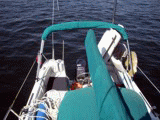 39. Deck
Mat. Wall Mart sells mats that fit perfect in the cockpit below
the companion way and on the cockpit seats where visiters first step when
entering from port or starboard. How does the dirt get aboard? Well that
stops some
of it. Of course this is where the technician will "hide" the key you gave
him when he is done working.
39. Deck
Mat. Wall Mart sells mats that fit perfect in the cockpit below
the companion way and on the cockpit seats where visiters first step when
entering from port or starboard. How does the dirt get aboard? Well that
stops some
of it. Of course this is where the technician will "hide" the key you gave
him when he is done working.
40. Electric cord bag. We keep towels in that when the cord is in use. A cord is an awkward thing on a pocket cruiser and is probably why our dealer fought us over shore power. The bag is helpful.
41. Denim Jeans. The name denim came from a cloth made in Nimes (de Nimes), France that was used by sailors from from Genoa, Italy, to make pants. The origin of the word jeans comes from sailors in southern Europe who were known as Gens. Hence denim jeans are worn by Pacific Northwest sailors even today. Sorry Prada.
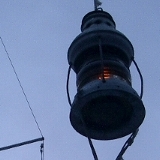 42. It
wasn't until my sixth year with Murrelet that I came to
understand
why my pocket cruiser wasn't fitted out with an anchor light. Mac26x
cruisers have steaming lights but these are not legal as anchor lights.
Nearly all sailboats have anchor lights at the top of the mast. This
actually is a very poor position because on a dark
night very few boaters are looking high enough above the waterline to
notice it. The most effective anchor light is hung just above the boom or
at about that position on the foredeck like where you would put it on a
powerboat. Less height is more effective.
42. It
wasn't until my sixth year with Murrelet that I came to
understand
why my pocket cruiser wasn't fitted out with an anchor light. Mac26x
cruisers have steaming lights but these are not legal as anchor lights.
Nearly all sailboats have anchor lights at the top of the mast. This
actually is a very poor position because on a dark
night very few boaters are looking high enough above the waterline to
notice it. The most effective anchor light is hung just above the boom or
at about that position on the foredeck like where you would put it on a
powerboat. Less height is more effective.
Well that is a top 42 list.
Joshua Slocum was from Nova Scotia, Canada. He owned several ships as well as commanding many others. After loosing one of his ships, the Aquidneck, on a sandbank in Brazil, he and his family sailed the Liberdade, a canoe of about 35 foot, from the site of the grounding to Washington DC USA, his new home. Perhaps owing to this demonstration of seamanship, a few years later a friend presented him with the honor of restoring the rotting oyster sloop that later became the famous 37 foot Spray. Three years later Spray embarked on her single-handed world circumnavigation. Slocum brought her 46,000 miles and wrote a book about the 3 year epic voyage which finished on June 27 1898. She inspires recreational sailors even today. Slocum is considered a hero of both Canada's and the United State's. If only more boat designers would be inspired by the Spray. Today there are over 5000 replicas of the vessel.
Slocum was a bluewater cruiser pioneer who was able to put his commercial sailing experience to good use in demonstrating proper design. His 138 foot bark Aquidneck had been used by his family for cruising and carrying cargo when the age of commercial sail was about over. It was common during this time for owners to skuttle their vessels for insurance but the Aquidneck was uninsured when she was lost. Slocum had been studying small boat design and was in the process of building a tender to Aquidneck at the time of the loss.
The Liberdade was that tender and she was junk rigged but also incorporated solid flotation in the form of bamboo bundles along her gunwales so that she would be self righting - not unlike RIBed tenders of the modern age. While being towed, Slocum must have realized that the design and construction allowed the vessel to exceed theoretical displacement hull speed safely. Charles J.Doane reports in Sail Magazine (May 2006 pg 70) that Liberdade was towed at an exciting 13 knots with Slocum's son ready to chop the tow line free but the vessel did not break up or show signs of being about to. This test likely inspired Slocum to sail at speeds not considered safe for a small displacement hull of her size and Liberdade covered 180 miles in one 24 hour period. While inspiring, I do not consider Liberdade successful in that Slocum's wife would not join Joshua on Spray for his circumnavigation telling him "Joshua, I have already made my voyage" on Liberdade. The two foot larger Spray is obviously successful given her replicas and this is among the reasons I have concluded that in a displacement hull the vessel must be at least 37 foot for bluewater cruising. A planing hull such as a Mac26x is the alternative.
Pocket cruising provides the experiance that Slocum enjoyed in sailing his converted centerboarder (the Spray) around the world and Guzzwell writes about in Trekka around the world. By definition a vessel under 27 foot is not a cruiser, she is a pocket cruiser. Not by coincidence, Mac26x pocket cruisers are powered and sized about half of what is considered to be a cruiser. It is pretty much accepted that a cruiser will be 40 to 60 feet long and have a 100 hp engine. The following is a cruiser.

When MacGregor Yachts stopped production of the X, my first thought was that the Mac65 or her stretch version, the Mac70, would soon be taking up factory production line space and that the M production run would be a short one, ment to satisfy Classic and 19 owners who wanted an upgrade that sailed similarly to the boat already owned as opposed to the revolutionary ways of a Mac26x. In 1995, when MacGregor Yachts first became swamped with orders for the newly introduced MacGregor 26x, the 65 was taken out of production to devote MacGregor's entire five acre site to the production of the 26x. "In future years, the big boat, the MacGregor 70, will again be coming off the MacGregor 65 Corporation production line." states Roger MacGregor in literature promoting the mac26m. Hopefully the Mac70 will feature solid flotation and water ballast and a centerboard rather than a fixed keel. Keels are discused in the next portion of this cruising log.
|
|
|
|
|
Updates at WordPress Blog Site
mighetto@eskimo.com - Internet email address
mighetto@compuserve.com - Internet email address or 72154,3467 from within Compuserve